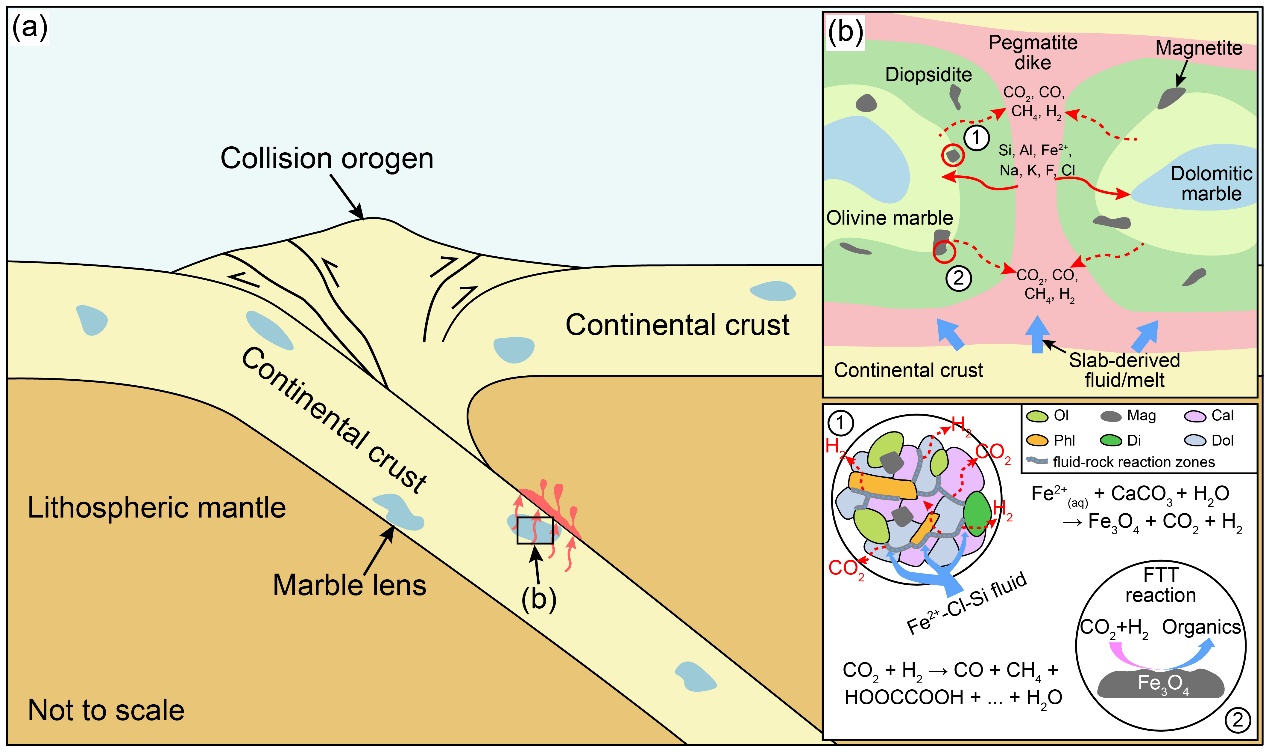Abiotic organic synthesis during geological processes has attracted considerable attention because it may have provided both the material and energetic foundation for the origin of early life on Earth. A research team led by Prof. GUO Shun and Prof. LIU Jingbo at the Institute of Geology and Geophysics, Chinese Academy of Sciences (IGGCAS), has reported direct geological evidence that infiltration of ferrous chloride-rich silicic fluids into dolomitic marble induced decarbonation reactions, generating H2 and magnetite, which in turn catalyzed abiotic organic synthesis. The findings were published in Proceedings of the National Academy of Sciences of the United States of America.
At Earth's surface and in shallow, serpentinization of mafic-ultramafic rocks oxidizes ferrous ion (Fe2+) to ferric ion (Fe3+) while reducing H2O to H2, which then drives abiotic organic synthesis in the presence of catalysts. Recent theoretical and experimental studies suggest that high-pressure and high-temperature (HP-HT) conditions may be even more favorable for abiotic organic synthesis; however, natural observations remain limited. Under such extremes, the mechanisms of H2 generation, abiotic organic synthesis, and their preservation remain poorly constrained.
To address this knowledge gap, the researchers conducted a comprehensive petrological study of metasomatic marbles from the Sulu ultrahigh-pressure metamorphic belt. These rocks, formed through infiltration of silica-rich fluids or silicate melts, include dolomitic marble (protolith), olivine marble (weakly metasomatized), and diopsidite (strongly metasomatized). Decarbonation occurred at ~218 Ma under conditions of 670−800 °C and >1.0 GPa, consistent with retrograde granulite-facies metamorphism of regional eclogites. These carbon-rich rocks, having experienced deep subduction and exhumation, provide ideal natural samples for investigating abiotic organic synthesis during HP-HT metamorphism.
High-resolution Raman mapping of 5000 zircon-hosted inclusions from metasomatic rocks revealed multiple organic compounds, including whewellite (CaC2O4•H2O), disordered carbonaceous material (aromatic rings with aliphatic hydrocarbon chains), and CH4. These organic species were found in association with volatiles (H2, CO, CO2, and H2O) and decarbonation minerals (olivine, phlogopite, calcite, magnetite, and diopside). These observations confirm that H2 and abiotic organic matter were generated during metamorphic decarbonation.
Detailed petrographic analyses and mass-balance calculations demonstrated that progressive metasomatism of dolomitic marble substantially increased bulk-rock Fe content, requiring significant external Fe input via ferrous chloride-rich fluids. Modeling constrains a minimum water/rock ratio of 2−9, with metasomatism produce ~72−142 mmol H2 per kg of metasomatic rocks. This is comparable to H2 production during the serpentinization of ultramafic rocks (~13−315 mmol/kg).
The magnetite formed during decarbonation subsequently catalyzed Fischer−Tropsch-type reactions between H2 and decarbonation-derived CO2 yielding CH4. The occurrence of whewellite further indicates the formation of more complex carboxylic groups.
In summary, infiltration of ferrous chloride-rich silicic fluids into dolomitic marble induced decarbonation reactions that generated H2 and magnetite, thereby facilitating abiotic organic synthesis during high-grade metamorphism. These results highlight the role of aqueous Fe in producing H2 and magnetite, offering new insights into potential geological hydrogen resources and the geochemical pathways relevant to the origin of early life on Earth.
This work was conducted in collaboration with Zhejiang Ocean University.
Funding was provided by the National Natural Science Foundation of China (NSFC, 92355301), the Chinese Academy of Sciences (XDB0710000), NSFC (42302061, 42172063), the China Postdoctoral Science Foundation (2023M743471), the Key Research Program of the IGGCAS (IGGCAS-202204), and the State Key Laboratory of Lithospheric Evolution, IGGCAS (SKL-Z202201). This study also contributes to the project of Theory of Hydrocarbon Enrichment under Multi-Spheric Interactions of the Earth.

Figure. Schematic illustration of H2 generation and abiotic organic synthesis during metasomatism of dolomitic marble by ferrous chloride-rich silicic fluids in a continental subduction zone (Image by FEI Chenhui).
Contact:
GUO Shun
Institute of Geology and Geophysics, Chinese Academy of Sciences
Phone: +86-10-82998534
E-mail: guoshun@mail.iggcas.ac.cn